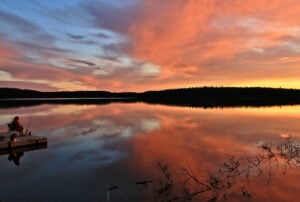
People & Culture
Q&A with Jeff Westeinde on Ottawa’s Zibi project
In the April issue of Canadian Geographic I wrote about Stratford, Ont.'s three decade struggle to repurpose the giant, neglected railway…
- 5118 words
- 21 minutes
Places
Islendingadagurinn, the Icelandic Festival of Manitoba, celebrated its 133rd year in Gimli, Manitoba while recognizing Icelandic culture and heritage

The entire town of Gimli, Man., takes on an unmistakably Icelandic hue during Islendingadagurinn, the annual Icelandic cultural festival. World-famous strongmen compete, and local delicacies like vínarterta (prune cake) and Brennivín (Icelandic aquavit) are plentiful. But even on a regular day in Gimli, you’ll hear Icelandic being spoken and see traditional Icelandic clothing being worn. For this town is New Iceland’s major centre — home to the largest Icelandic population outside of Iceland.
The town was established in 1875 as a “reserve for Icelanders,” many of whom were fleeing poor living conditions. New Iceland was a part of a series of reserve schemes set up by the federal government in the 1870s to establish populations of European ethnic minorities — Mennonites, Doukhobors and Icelanders — both in Manitoba and what was then the North-West Territories. The land, comprising an 18-kilometre-wide tract running along the shores of Lake Winnipeg for about 68 kilometres, was chosen for its relative fertility and proximity to the proposed route of the Canadian Pacific Railway. (The line was originally slated to run through nearby Selkirk, but — terrified of being relegated to the status of insignificant backwater — the City of Winnipeg convinced the railway company to divert the new line further south by offering up free land, tax exemptions and a $200,000 bridge.)

New Iceland’s early successes were largely thanks to cooperation with local Anishinaabe, Cree and Métis.

Unlike reserves established for First Nations through the Indian Act, where political enfranchisement was withheld from those living on reserve, inhabitants of New Iceland, created through the Dominion Lands Act, were eligible for full Canadian citizenship over time. The immigrants were favoured by the Canadian government “in part based on ideas about who they were in terms of their racial fitness to be colonists in the northwest,” according to Ryan Eyford, author of White Settler Reserve: New Iceland and the Colonization of the Canadian West. However, after a few years of failed fishing, homesteading and politicking, public opinion began to turn against the Icelandic transplants.
In an 1877 piece, a writer for the Manitoba Free Press described New Iceland’s population as an “effete and unprogressive race, who were not equal to the struggle of life on this continent and must inevitable [sic] succumb to the fate of the ‘least fit’.”
Ironically, given that New Iceland’s establishment displaced many First Nations people, New Iceland’s early successes were largely thanks to cooperation with local Anishinaabe, Cree and Métis, who passed along valuable knowledge that helped the newcomers survive. Indeed, my own great-great-grandfather, Gestur Oddleifsson, endured and eventually prospered thanks to Joseph Monkman, a half-Cree, half-Scottish man who taught him survival skills after Oddleifsson’s father died of smallpox when he was just 11.
Today, a hulking Viking statue stands proudly in the centre of Gimli’s Viking Park. It was erected in 1967 to commemorate the 100th anniversary of Canadian Confederation. The surrounding park opened in August 2017 for the125th Islendingadagurinn and just after Canada 150 festivities.
Though the ties to Canada now run deep, listen closely to the din of the crowd during Islendingadagurinn and you’re likely still to hear the sonorous hum of a little island in the North Atlantic. And when the Icelandic strongman strains to heave a Sisyphean mass into the air, you may catch him uttering a hushed “helvítis” under his breath, the same curse in Old Norse as my great- great-grandfather would have made.
Are you passionate about Canadian geography?
You can support Canadian Geographic in 3 ways:

This story is from the November/December 2022 Issue

People & Culture
In the April issue of Canadian Geographic I wrote about Stratford, Ont.'s three decade struggle to repurpose the giant, neglected railway…

People & Culture
The story of how a critically endangered Indigenous language can be saved

History
Sites across Canada honouring the war

Travel
When your heart needs to roam, these 10 iconic Manitoba experiences will be waiting